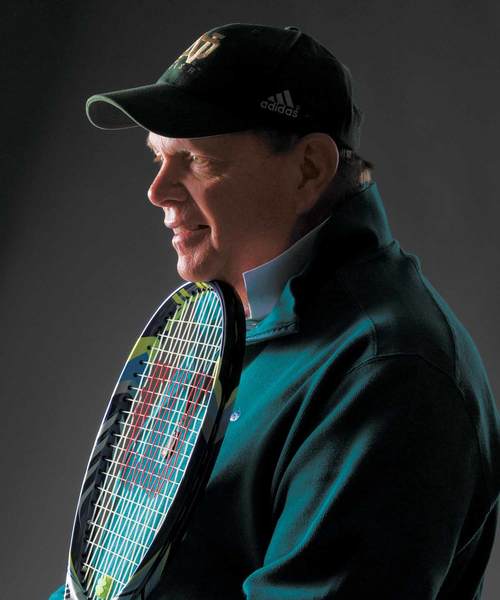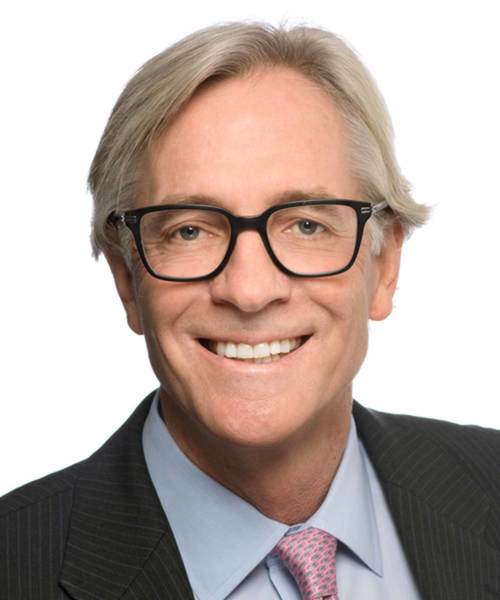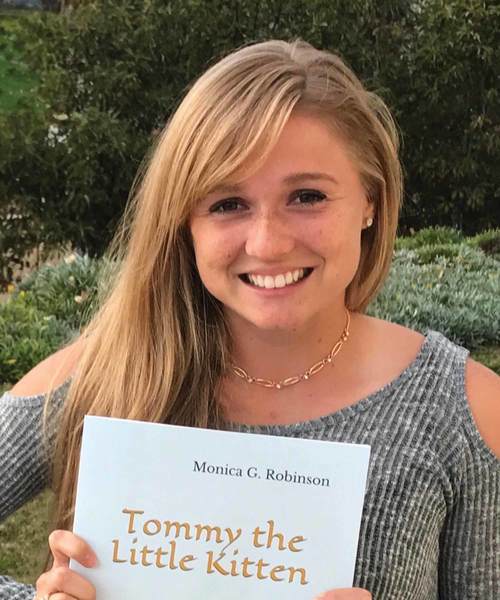
Bob Bayliss
He mentored hundreds
When more than 60 former University of Notre Dame tennis players returned in late September to celebrate the retirement of coach Bob Bayliss after 26 years at the helm, their love for the living legend gushed like a river.
Only three players representing different eras were supposed to talk, but the floor was opened and the stories just flowed.
Sure, Bayliss walked away with the fifth most career wins ever at 765 and with his ninth BIG EAST Conference title, and he was named conference coach of the year 15 times and national coach of the year twice—but the players didn’t talk of his accolades.
They thanked him for making them better players, but also for being the father figure of their young adult lives. They told stories of his early-morning workouts, favorite sayings, stringent rules and eccentricities. Mostly, they spoke of a family atmosphere of encouragement and support synonymous with the values Notre Dame holds dear. And of how their relationships with him have become stronger over the years.
“I only hope that when my career comes to a close, I will have made half of the impact he’s made on so many lives,” said 1993 graduate (and All-American) Andy Zurcher, now a Denver business executive.
Heads nodded when others talked about Bayliss’ ability to make everyone feel important, from the number-one singles player to the last guy on the bench. And they shook with laughter at his skillful way of adapting his motivational methods to the needs of different personalities.
Eric Enloe (a 1998 graduate) fondly told of when he was choking badly in the deciding match against a highly-ranked Duke team. Bayliss told Enloe between games that he was recruited because he was a tough little guy. “I was half right,” Bayliss said. “Now, I realize you’re just short.” Stunned and angry, Enloe stormed back from a 4-0 deficit to capture the individual and team victory.
David DiLucia received the opposite approach. He had just broken serve in the semifinals of the 1992 NCAA Championships against top-ranked USC. He only had to serve out to ice the biggest victory in the program’s modern history.
But Bayliss could see from DiLucia’s slumped shoulders that the weight of the moment suddenly settled on the high-strung player. So, during the change, the coach sat next to his star and pulled out a huge hotel key. He pointed to an attractive blonde in the stands, saying that she asked him to give her room key to DiLucia—but only if he wins the match. DiLucia laughed out loud, relaxed and didn’t lose a point in the final game.
“In a tense situation, there’s not much you can do in an individual sport like tennis,” Bayliss would say later. “So you either make them mad or make them laugh. But you have to learn what will work for each player, and that can take some trial and error.”
Bayliss grew up in Richmond, Va., and learned to play tennis on a public court in a city park program that also produced Arthur Ashe. Though Ashe was only a year older, Bayliss said he regrets that he never got to play the tennis icon during those segregated times and didn’t even meet him until many years later.
At the University of Richmond, Bayliss decided to try to make the tennis team despite not being recruited. A scrappy work ethic helped him claw his way from the bottom of the bench to number-two singles his senior year—and gave him an appreciation for unheralded players.
Bayliss said his mentor was a local country club tennis pro who hired him for his first tennis job giving youth lessons. He said Fred Koechlein not only knew tennis, but “he insisted that everyone involved in his operation represent the highest standards.” That included the kids standing when adults entered the room, and the young coaches giving tips to the wait staff when they ate the free meals that came with the job.
After he graduated from Richmond in 1966, he planned to go into the military before being drafted but instead flunked his physical. He’d hoped to use the GI bill for graduate school, so he was stunned and uncertain what to do until his college coach suggested a plan: coach tennis at Richmond in exchange for graduate school tuition. He would later model his program after both coaches, insisting on decorum and reaching out to help former players whenever possible.
The following year, Bayliss taught English and coached at his former high school, leading the team to an undefeated season and state championship. He was surprised by a call from the Naval Academy asking him to interview for a coaching position. He married that summer and the honeymooners went to Annapolis, accidentally walking in for the job interview together. He would go on to amass a record of 248–80.
He also learned to thrive under pressure, because the Army–Navy match is treated like the Super Bowl in every sport at the academies.
Navy had lost for 10 straight years before he arrived, yet he won every match in 15 years, the only coach in school history never to lose to Army.
For good measure, he even went undefeated against Army in four years coaching squash.
Bill Mountford, a Notre Dame technology administrator today, was the captain of Bayliss’ 1983 team. Now coaching girls tennis at St. Joseph’s High School in South Bend, Mountford said he often finds himself repeating lines he heard from Bayliss: “Early morning practices are easy—just sleep in your tennis clothes.”
“Coach changed my life,” Mountford said. “He convinced me to come to the Naval Academy. He convinced an east coast Protestant to apply to Notre Dame for an MBA. He introduced me to my wife (Notre Dame deputy athletics director Missy Conboy), and 24 years later, I’m a Hoosier and he’s the godfather to our oldest girl.”
Mountford worked as Bayliss’ assistant and learned the importance of preparation as a player and coach. They still eat lunch together regularly. The two often quiz each other on the opponent and outcome of past matches. “I remember them all, and I may not remember where my car keys are,” Bayliss said.
With four young children to support, all of whom would later graduate from Notre Dame, Bayliss took a summer job at a country club near Boston. To increase hours there, he became coach at MIT in 1984 and stayed for three years before getting a call from Notre Dame.
He had surprised his devout wife Pat by converting to Catholicism while at Navy, where a player became his godfather. But what finally convinced him to come to turn around an underperforming program was a University commitment to fully fund tennis scholarships after building the Eck Pavilion, an indoor facility crucial for a cold weather location. Now he just needed some players.
DiLucia’s father called to arrange a visit in January 1988, just hours after Bayliss learned that his father had passed away. Distraught, the coach did not register that the top-ranked recruit in the country was coming, and he said to have the boy stop by when on campus. Later realizing his mistake, he owned up to it, described the situation and bonded with the elder DiLucia, who had recently lost his own father. Landing such a prominent recruit gave the program instant credibility and kick-started a new trajectory.
“I believed in him when he said I could be a part of creating something special, and he delivered,” DiLucia said.
The team went 24–3 in 1990 and was ranked 16th nationally but still didn’t make the 20-team NCAA Championships, a snub that fueled later runs. Notre Dame would make the cut 21 of the next 22 years. In 1992, DiLucia was the top-rated player in the country and led a run to the finals, handing USC its only NCAA loss in a four-year span. Bayliss penned a poem about it for the next year’s program.
Player after player talked about Bayliss’ ability to communicate his message in different ways. Many spoke of struggling early with the transition to college: managing the time demands of tennis and the classroom, changing their focus from themselves to the team and growing into responsible young men. He sat each down and laid out his expectations.
One testament to Bayliss’ methods is that most of his 19 All-America players improved to reach that level only as seniors. “I tried to recruit good people,” Bayliss said. “You have to ask yourself, no matter how good he is, can I live with him for four years?”
Javy Taborga recalled a conversation with coach his sophomore year. Bayliss told him he needed to work harder to take advantage of a once-in-a-lifetime opportunity.
“I thought regular practice was enough, but he said I would regret it later if I didn’t give 100 percent,” Taborga said from Venezuela, where he is an investment banker. “We all changed after that and followed team rules to the max. No one would have believed I would become an All-American after my sophomore year. I have been able to use that lesson the rest of my life.”
Bayliss insisted the team shave and travel in coat and tie even though they would often run into other teams in sweat suits. Poor sportsmanship or throwing rackets were not tolerated. If a player absolutely needed to study, he could miss practice.
“He was a stickler for doing things right,” said Brian Patterson, a 1999 graduate. “Dressing up seemed ridiculous when you’re 18, but he reinforced that we represent Notre Dame. It wasn’t enough to be here.
We had to live up to the tradition we inherited.”
Sean McGraw said hearing the stories at Bayliss’ retirement celebration reminded him of why he stuck out four years as a walk-on despite never playing in matches. He said the weekend resembled Mr. Holland’s Opus, where the former students’ tribute to their teacher is the people they have become.
“He is able to create a sense of community that people want to be a part of,” said McGraw, now a Holy Cross priest and Notre Dame professor. “He always believed you could be better and be a part of something special. I owe a lot of what I have done since to coach.”
Ryan Sachire, a 2000 graduate and player who ranked number two nationally under Bayliss, has succeeded his coach after working as an assistant the last seven years. He hopes to emulate his mentor.
“You knew he was with you for the long haul,” Sachire said. “The way he ran the program was always with a bigger perspective. It was not just what you could achieve in four years but in the future, too.”
Bayliss, who was inducted into the Intercollegiate Tennis Association Hall of Fame in May 2013, said the greatest thrill of coaching is keeping in touch with former players as they grow to success. In his new role as manager of tennis facilities, he is excited to watch Sachire’s team.
He now finally has time to write a book. He plans to start at the last BIG EAST Championship and then hopscotch backwards to reflections from his whole career, giving his wife much of the credit. Motivating himself, Bayliss already has a title chosen: “Crosscourt Reflections.”
Coach, it’s your serve. The pen is in your court.

